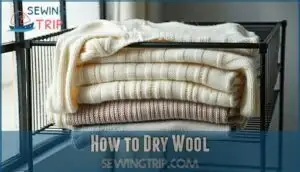This site is supported by our readers. We may earn a commission, at no cost to you, if you purchase through links.

It’s kind of like that friend who hates surprises—they don’t handle sudden changes well. Heat, hot water, or too much agitation can cause the fibers to tighten, making your favorite sweater two sizes smaller.
Stick to cold water and gentle detergent, and try hand washing if you can. If you’re using a machine, go for the wool or delicate cycle.
Avoid dryers altogether—wool prefers air drying on a flat surface. Treat it kindly, and you’ll keep it soft, cozy, and wearable longer.
Want more tips for happy wool? Keep reading!
Table Of Contents
Key Takeaways
- Wool shrinks when exposed to heat, moisture, and agitation, so always use cold water and minimal movement when washing it.
- Hand wash your wool garments with a gentle, enzyme-free detergent or use the delicate/wool cycle on your machine.
- Avoid dryers entirely—air dry your wool flat on a rack and reshape it while it’s damp to maintain its size and shape.
- Use proper storage methods like breathable cotton bags and fold garments to prevent stretching or damage, using minimal movement.
Does Wool Shrink in The Wash?
Yes, wool can shrink in the wash, and it happens more often than you’d think.
Wool shrinkage is caused by a mix of heat, moisture, and agitation, which make the tiny scales on wool fibers latch onto each other, permanently shrinking the item.
Heat, moisture, and agitation are wool’s worst enemies, causing fibers to interlock and garments to shrink permanently.
Wool types matter too—regular wool is more prone to shrinking than blends, which resist shrinkage better.
The detergent you use plays a significant role, especially if it contains enzymes that damage wool fibers.
Washing wool incorrectly can turn your favorite sweater into something doll-sized.
To avoid this, use cold water, minimal agitation, and a gentle, wool-safe detergent.
Understanding wool fiber shrinkage mechanisms and proper washing methods helps you keep your garments safe and wearable for longer.
To prevent this, consider preshrinking wool fabric before sewing.
What Causes Wool to Shrink?
Wool shrinkage happens when heat, moisture, and agitation affect its unique fiber structure.
Wool fibers are coated with tiny scales that interlock under these conditions, leading to felting. Without lanolin, which processing removes, wool becomes even more prone to shrinking.
Agitation damage and heat effects worsen this, as fibers tighten and distort. Different wool types react differently—shorter fibers shrink faster.
To avoid unwanted changes, handle wool with care to protect the wool scale interaction and prevent permanent damage to garments. Hence, it’s vital to examine methods for preshrinking to mitigate these effects, considering the importance of preshrinking to maintain the quality of wool garments.
How to Hand Wash Wool
Hand washing wool is simple and helps prevent shrinking. Start with lukewarm water and an enzyme-free wool detergent. Gently swish the garment—avoid rubbing, as wool fibers need minimal agitation.
Hand wash wool gently with lukewarm water and enzyme-free detergent to maintain softness and prevent shrinking.
Rinse twice with water at the same temperature to avoid shocking the fibers. For drying:
- Gently press out water without wringing.
- Roll in a towel to soak up excess moisture.
- Lay flat on a rack, away from sunlight.
- Reshape gently while damp.
Using a specialized wool wash guarantees gentle cleaning. These wool care tips preserve softness and shape for longer.
How to Machine Wash Wool
Caring for wool in the washing machine requires thoughtful steps to prevent shrinking.
Follow these tips:
- Washer Settings: Choose a gentle or wool-specific cycle with cold water and a slow spin speed to avoid fiber stress.
- Detergent Choice: Use enzyme-free wool detergent to keep fibers intact and prevent felting.
- Mesh Bags: Protect garments by placing them in mesh bags to reduce agitation. Consider using a specialized wash bag for extra protection.
By following these wool washing tips, you’ll keep your knits safe while maintaining their shape and softness.
How to Dry Wool
Drying wool properly helps maintain its shape and size, preventing unwanted shrinkage. With the right techniques, you can guarantee your wool garments stay soft, smooth, and ready to wear.
Airdrying
Airdrying is the safest way to avoid wool shrinkage.
Lay your garment flat on a drying rack, away from direct sunlight, to prevent sunlight exposure or distortion.
Gently press out excess water without wringing, ensuring proper airflow.
Use a stretching technique while damp to maintain shape.
Consider using a specialized drying apparatus for best results.
Wool drying takes patience, but it’s worth it for lasting care.
| Step | Action | Why It Matters |
|---|---|---|
| Flat Drying | Lay flat on a drying rack | Prevents shrinking and misshaping |
| Avoid Sunlight | Dry away from direct sunlight | Reduces damage to fibers |
| Press Gently | Press water out without twisting | Prevents unnecessary fiber stress |
| Rest Shape | Reshape while damp | Keeps your garment looking great longer |
Pressing
After washing, pressing wool properly helps maintain its shape and prevents damage.
Avoid squeezing or wringing excess water; instead, blot it gently with a towel. Carefully stretch the fabric back to its original form while making certain it’s evenly shaped.
To smooth wrinkles and refresh wool fibers, use these pressing techniques:
- Set your iron to a low temperature and use a clean pressing cloth to shield the wool from direct heat.
- Steam pressing with a garment steamer or steam setting on your iron works wonders for removing creases.
- Block the wool by pinning it into shape on a flat surface and letting it air dry fully.
Proper pressing preserves the fabric’s texture and makes certain your wool garments stay shrink-free and in great condition.
Wool Maintenance Tips
Taking care of wool doesn’t have to be complicated if you know the basics.
From proper ironing to smart storage, a few simple steps can keep your wool garments in great shape for years.
Ironing
After drying, wool sometimes needs ironing to remove creases. Set your iron on low heat to prevent damage or wool shrinkage. Always use a pressing cloth as a barrier between the fabric and iron to avoid shiny spots or burns.
Steaming wool is an excellent alternative for wrinkle removal. Steam relaxes the fibers without direct heat, making it safer for delicate knitwear. Keep motions small and press gently.
Here’s a quick guide:
| Technique | Benefit |
|---|---|
| Low heat setting | Prevent damage and shrinkage |
| Use a pressing cloth | Protects wool’s surface |
| Steam option | Safe for delicate fibers |
Gentle care guarantees your wool stays neat and ready to wear!
Sweater Storage
Proper sweater storage helps extend the life of your wool garments. Wool needs breathing room, so avoid plastic covers that trap moisture. Instead, store your wool sweaters in breathable cotton bags, which allow airflow and help with moth prevention.
Always fold instead of hanging to prevent stretching.
- Seasonal Rotation: Regularly rotate sweaters, storing off-season items securely.
- Space Saving: Use under-the-bed bins or flat totes to maximize space.
- Humidity Control: Keep sweaters in dry areas to avoid musty odors or wool shrinking.
Following these sweater care tips guarantees effective shrinkage prevention and keeps your wool looking great for years.
Frequently Asked Questions (FAQs)
Does wool shrink when you wash it?
Wool shrinking can feel like your favorite sweater’s betrayal.
It happens when heat, moisture, and motion combine, causing the fibers to interlock.
To prevent it, wash gently in cool water, avoid agitation, and air-dry flat.
Why does wool shrink in a washing machine?
Heat, agitation, and water team up in the washing machine, causing wool fibers to interlock.
The protein scales on each fiber catch on one another, tightening and shrinking the fabric permanently, often leaving sweaters unrecognizable, due to the heat and agitation.
Does wool shrink in cold water?
Like Achilles’ heel, wool’s weakness isn’t just heat—it’s also motion.
In cold water, wool won’t shrink as much, but rough handling or agitation can still tangle its fibers.
Gentle care keeps it safe!
Why does wool shrink so much?
Wool shrinks because its fibers have tiny scales that interlock when exposed to heat, moisture, and agitation.
Without proper care, these scales tighten and tangle, causing the fabric to shrink, often permanently.
How do you shrink wool?
Think of wool like a sensitive roommate—it’s quiet until you crank up the heat or stir up trouble.
To shrink it, soak in hot water, agitate gently, then dry with low heat for precision.
Can You Wash a wool blend if it doesn’t shrink?
You can wash a wool blend without shrinking it if the wool content is below 50%.
Use cold water, a gentle cycle, and avoid excessive heat or agitation to keep the fabric intact.
Can you put 100% wool in the dryer?
You shouldn’t put 100% wool in the dryer.
Wool shrinks easily under heat and agitation, turning it into a smaller, felted version of itself.
Air-drying it flat is the safest way to preserve its shape.
How do you keep wool from shrinking in the wash?
To keep wool from shrinking, handwash it in cold water with a gentle, enzyme-free detergent.
Avoid agitation, twisting, or wringing.
Lay it flat to dry, reshaping as needed.
Always follow the care label instructions.
What happens when you wash 100% wool?
When you wash 100% wool, heat, moisture, and movement team up to make the fibers interlock, leading to shrinkage and felting.
Gentle care—cool water, mild soap, and minimal agitation—can help prevent this.
Is it possible to restore shrunken wool?
Yes, you can restore shrunken wool by soaking it in lukewarm water with conditioner, gently stretching it to its original size, and air-drying flat.
While results vary, this method helps relax and reshape fibers effectively.
Conclusion
Caring for wool is like tending a delicate garden—treat it thoughtfully, and it thrives.
Yes, wool shrinks in the wash when exposed to heat, hot water, or too much agitation, but with careful steps, you can preserve its shape and feel.
Stick to cold water, gentle detergent, and avoid dryers.
Hand wash or use the wool cycle on your machine, then air dry flat.
Follow these tips, and your wool pieces will stay soft, cozy, and long-lasting.
- https://www.gentlemansgazette.com/how-to-wash-maintain-wool-sweaters/
- https://www.fitssock.com/blogs/a-fits-blog/does-merino-wool-shrink-when-washed
- https://merinoprotect.com/blogs/merino-care/how-to-shrink-and-unshrink-merino-wool?srsltid=AfmBOop5o7c9nPEn9EjdzC274ty-FLKZ-xEtMEkKC2beNVr7aJjZCpEk
- https://www.woolmark.com/care/can-i-wash-wool-in-the-washing-machine/
- https://steamerystockholm.com/8-myths-and-truths-about-washing-wool?srsltid=AfmBOoqGGp1QgTBs-wIQOUUdERIlmKTQ_vuiziYU6Zwc2ShrjC7cGni5









